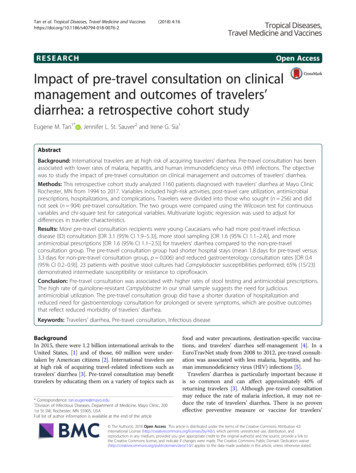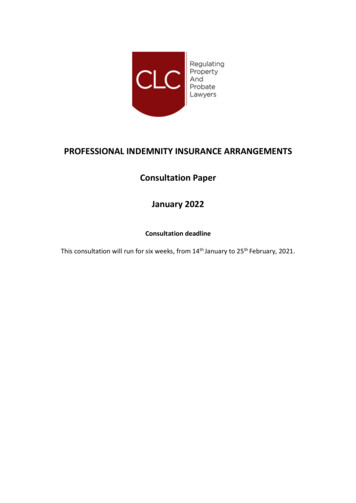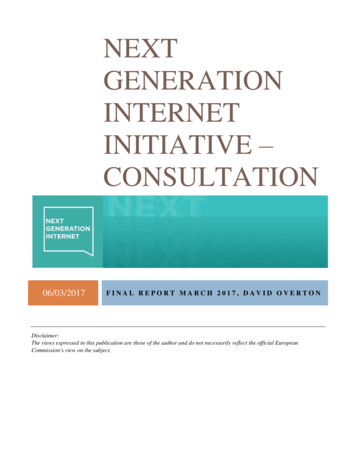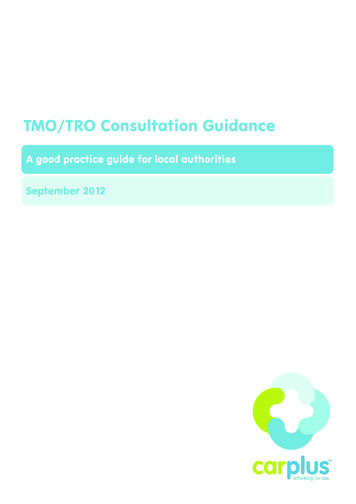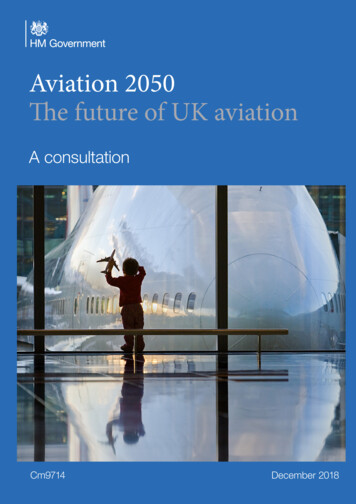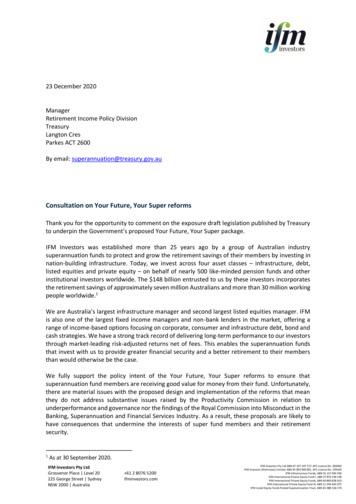
Transcription
23 December 2020ManagerRetirement Income Policy DivisionTreasuryLangton CresParkes ACT 2600By email: superannuation@treasury.gov.auConsultation on Your Future, Your Super reformsThank you for the opportunity to comment on the exposure draft legislation published by Treasuryto underpin the Government’s proposed Your Future, Your Super package.IFM Investors was established more than 25 years ago by a group of Australian industrysuperannuation funds to protect and grow the retirement savings of their members by investing innation-building infrastructure. Today, we invest across four asset classes – infrastructure, debt,listed equities and private equity – on behalf of nearly 500 like-minded pension funds and otherinstitutional investors worldwide. The 148 billion entrusted to us by these investors incorporatesthe retirement savings of approximately seven million Australians and more than 30 million workingpeople worldwide.1We are Australia’s largest infrastructure manager and second largest listed equities manager. IFMis also one of the largest fixed income managers and non-bank lenders in the market, offering arange of income-based options focusing on corporate, consumer and infrastructure debt, bond andcash strategies. We have a strong track record of delivering long-term performance to our investorsthrough market-leading risk-adjusted returns net of fees. This enables the superannuation fundsthat invest with us to provide greater financial security and a better retirement to their membersthan would otherwise be the case.We fully support the policy intent of the Your Future, Your Super reforms to ensure thatsuperannuation fund members are receiving good value for money from their fund. Unfortunately,there are material issues with the proposed design and implementation of the reforms that meanthey do not address substantive issues raised by the Productivity Commission in relation tounderperformance and governance nor the findings of the Royal Commission into Misconduct in theBanking, Superannuation and Financial Services Industry. As a result, these proposals are likely tohave consequences that undermine the interests of super fund members and their retirementsecurity.1As at 30 September 2020.IFM Investors Pty LtdGrosvenor Place Level 20225 George Street SydneyNSW 2000 Australia 61 2 8076 5200ifminvestors.comIFM Investors Pty Ltd ABN 67 107 247 727, AFS Licence No. 284404IFM Investors (Nominees) Limited, ABN 56 003 969 891, AFS Licence No. 239169IFM Infrastructure Funds, ABN 91 157 945 930IFM International Private Equity Fund I, ABN 27 876 336 538IFM International Private Equity Funds, ABN 40 869 828 619IFM International Private Equity Fund III, ABN 21 393 445 075IFM Listed Equity Funds Pooled Superannuation Trust, ABN 81 088 318 274
We have focused below on key issues relating to addressing underperformance and the bestfinancial interests duty.Addressing underperformance in superannuationWe support the policy intent of the reforms to provide members with better information aboutperformance and to weed out underperforming funds, which can significantly erode members’retirement savings through lower net returns.The Productivity Commission recommended an enhanced member outcomes test, which was: based on the principle of appropriate benchmarking; inclusive of all fees and costs, including administration fees; and covered all products, including choice products.In addition, the Productivity Commission recommended that all fees should be tied to a costrecovery mechanism. It is important that the proposed annual performance test mirrors thisapproach and covers a broad range of super funds, including products identified by the ProductivityCommission and APRA as chronic underperformers. It should also reflect outcomes for membersnet of all fees, including administration fees. This is what is relevant to fund members because it iswhat is ultimately available to fund their living standards in retirement.As IFM is not a superannuation fund, we will not be subject to the annual performance test, althoughthe net returns that our investors receive will be incorporated into the aggregate net returns ofsuperannuation products and compared against a composite benchmark based on each product’sportfolio asset allocation.Our concerns about the proposed performance test are similar to those raised by many otherindustry participants and stakeholders, and relate to: the likelihood that the test will improperly assess performance and provide potentiallymisleading information to superannuation members; its failure to assess the performance of trustees for total portfolio asset allocationstrategies, despite the choice of asset allocation strategy being the most important driverof returns for members; the incentives it creates for trustees to focus on the management of risk and returnsrelative to the Your Future, Your Super composite benchmark rather than absolute riskand returns to members; and the disincentives it creates for investing superannuation savings into real and unlistedassets which deliver returns for fund members and support productivity growth and jobcreation in Australia.We have particular concerns about the proposed treatment of unlisted infrastructure in thebenchmarking methodology. Unlisted infrastructure investments are an important contributor to
member returns, with Australian super funds collectively having 111.8 billion allocated toinfrastructure. More than three quarters of this allocation is in unlisted infrastructure.2Industry (profit-to-member) super funds typically have a higher allocation to infrastructure thanother types of funds. IFM invests on behalf of a number of these funds, as well as other Australianand global investors, through two open-ended, pooled funds in Australian and global infrastructure.Together, they represent 65.7 billion in assets under management, equivalent to more than half ofall Australian superannuation funds’ allocation to the infrastructure asset class. 3 The continuedgrowth in the number of institutions who choose to invest in our infrastructure funds goes to ourtrack record of strong performance.The use of a listed index – specifically, the FTSE Core Developed Infrastructure Index hedged to AUD(the “FTSE” index), as set out in the 2020-21 Budget documents – is not an appropriate benchmarkfor unlisted infrastructure. It will incentivise funds to build higher risk, less well diversifiedportfolios, and at the same time disincentivise investing in Australia. Such portfolios will bedetrimental to outcomes for members, and indeed the country.Generally, listed infrastructure indices demonstrate high correlation with broader listed equitiesportfolios. This makes them poor benchmarks for unlisted infrastructure exposures, which investorsoften use to diversify a portfolio away from listed market volatility and provide earnings stabilityand protection from inflation. Unlisted infrastructure exposures also offer investors a premium forcontrol and influence over the way an asset is managed; this is an opportunity to build and sustainvalue in a way that is very different to a listed index where the underlying components are typicallyowned by minority interests.Additionally, the FTSE index has a highly skewed composition, and is unrepresentative of typicaldiversified unlisted portfolios. By definition, the FTSE index is constrained to those infrastructuresectors and geographies where infrastructure has been listed on a public exchange. The FTSE index is heavily exposed to North American infrastructure (two-thirds of the indexis US-domiciled) whereas infrastructure funds like IFM’s typically invest in core assets acrossthe OECD and selectively in other regions. Australian superannuation funds will also tendto favour Australian infrastructure, given it delivers long-term returns in excess of Australianinflation, which is most relevant to the saving needs of members. Listed Australianinfrastructure contributes just 2.7 per cent to the FTSE index. The use of the FTSE indexwill encourage superannuation funds to invest offshore, rather than supporting the localeconomy. The FTSE index is concentrated in the utilities, railroads and conventional electricity subsectors, as the sectors that have historically been listed. The index has a very low allocation(only 4 per cent) to transport (marine ports, airports, roads), social infrastructure, waterinfrastructure and other subsectors. Transport comprises the largest sub-sector of IFM’sAustralian and global infrastructure funds.These substantial differences between the composition of a concentrated benchmark and the moretypical diversified underlying exposures of unlisted portfolios, which have access to a much broaderset of opportunities, will in turn generate very different returns between them. If US utilities areperforming well relative to Australian ports, the superannuation funds’ infrastructure investments23APRA (2020), Quarterly superannuation performance statistics, published 24 November 2020.As at 30 September 2020.
will be deemed to be underperforming, even if the Australian port exposure is delivering solidreturns to members. This noise in the performance outcomes, which the industry calls “trackingerror”, becomes a material risk to the superannuation funds, given it could jeopardise their ongoingexistence. This creates a strong incentive to reduce this risk, which can only be done by aiming totrack the exposures of the benchmark, and in doing so creating less diversified portfolios with higherrisk to members’ savings.With very limited listed infrastructure available in Australia, superannuation funds will likely pushallocations to infrastructure offshore and have reduced appetite to invest in assets that supporteconomic growth and deliver critical services to the Australian community. In turn, this may increasethe cost of capital for privately financed Australian infrastructure, and increase the reliance onforeign investors to fund our economic growth and productivity.We recognise the methodological challenges in assessing the performance of infrastructureinvestments, given Australia has only a few listed infrastructure companies and there is no industrystandard for benchmarking the performance of unlisted infrastructure investments. Thebenchmarking adopted by global institutional investors varies across absolute return, “CPI ”, fixedincome index and hybrid approaches, as different investors have different goals and risk tolerancesfor their infrastructure portfolios. These challenges in methodology as well as data availability werenoted by the Productivity Commission and have been broadly recognised in discussions we havehad in recent weeks with superannuation funds, asset consultants, infrastructure managers andother stakeholders.In our preliminary analysis of potential alternative benchmarks, all three categories of benchmarks(listed, appraisal based and marked-to-market) have demonstrated significant limitations. We canprovide further insights to the pros and cons of the various listed benchmarks available (e.g. the S&PGlobal Infrastructure Index, the MSCI World Infrastructure Index) although a listed index will alwaysintroduce basis risk and is inappropriate for an asset class that typically comprises a majority ofunlisted real assets. Alternatively, unlisted indices tend to suffer from the issue that datacontributions are voluntary and there is a history of managers coming in and out of these indices atwill, which brings into question the integrity of the performance benchmark.Many key global competitors to Australian funds have used, and continue to use, “CPI ” stylebenchmarks for their infrastructure portfolios. This generally provides them with greater flexibilityto buy the right asset mix to support their overall target objectives for their members, namelysignificant real growth in members’ retirement savings. Common benchmarks, both in Australia andinternationally, are CPI X per cent, where X ranges from 3 to 5 per cent. This level of real growthis consistent with the “mid-risk” market position infrastructure asset allocation occupies, whichshould, over the long term, deliver returns that are significantly in excess of a fixed interest portfoliobut more stable than a higher risk broad-based equities portfolio. It is also what investors broadlyseek to achieve by making an allocation to unlisted infrastructure as part of portfolio constructionconsiderations and may be the most appropriate to accurately benchmark such a diversified assetclass.We understand that the full benchmarking methodology for the annual performance test will be setout in the regulations for the Treasury Laws Amendment (Measures for a Later Sitting) Bill 2020:Addressing Underperformance in Superannuation, due to be released for public consultation in early2021. We would appreciate further engagement with the Government and regulators as theregulations are developed and will continue to work with industry partners to build consensus onpossible solutions.
As part of this consultation process we may also have further comments to make in relation tobenchmarking the performance of investments outside of infrastructure equity. The proposedapproach for fixed interest, for example, does not account for floating rate based fixed interestinvestments, a significant and growing part of the fixed interest market and an option that canprovide investors with improved capital protection during periods of high interest rate volatility. Itwill also be important that the performance test does not disincentivise investment in privateequity, an increasingly important source of capital and driver of innovation for Australianbusinesses, with a track record of strong performance for super funds and their members.As a final comment I would note that, during my 13 years at the Future Fund as Chief InvestmentOfficer and Chief Executive Officer, we consistently made a point of downplaying the role ofperformance benchmarks in large part because of the types of issues discussed in this submission.The Future Fund has never published a benchmark return beyond the long-term CPI mandate returnassigned to it by the Government. Superannuation funds similarly target a long-term CPI return.The Government should be very wary of the unanticipated consequences of introducing theperformance benchmarks as currently contemplated in the Your Future, Your Super package andsupporting legislation.Best financial interests dutyAt IFM, the best financial interests of superannuation and pension fund members are at the heartof our purpose, which is to protect and grow the long-term retirement savings of working people.While we agree that trustees should act in the best financial interests of members, the proposedchanges to the Superannuation Industry (Supervision) Act 1993 are not proportionate nor justified,and are likely to increase costs and legal uncertainty for trustees.In particular, we have concerns about the provision to allow regulations to be made to specify thatcertain payments or investments made by trustees of super funds are prohibited, or prohibitedunless certain conditions are met. The Explanatory Materials do not set out the rationale for thisextraordinary power, and it appears that the regulations could be used to prohibit payments orinvestments which are subjectively determined to not be in the best financial interests of fundmembers. Rather than remove ambiguities in relation to trustees’ duties, this provision wouldintroduce significant legal uncertainty, only enhanced by the fact that these powers would beembedded in regulation rather than primary legislation, with more limited scope for industryconsultation and proper parliamentary debate.The potential application of this provision to asset managers is unclear, although the ExplanatoryMaterials set out that a prohibition would extend to third party intermediaries used by trustees to“procure” an investment on their behalf. As a global funds manager, IFM makes investmentdecisions on behalf of not only Australian super funds but all investors who have chosen to invest inour funds and products. Insofar as particular types of investment may be prohibited, we areconcerned that this provision could pose a conflict with our duty in relation to protecting the bestfinancial interests of all of our investors. This represents an unacceptable risk to commercialdecision-making for external managers offering services to superannuation funds, and could putsuch managers at a disadvantage in relation to competitors for infrastructure or other assets –ultimately limiting the benefits of scale and reducing returns for superannuation fund members.Furthermore, the provision is not necessary given the power of the regulators to pursue breachesof the best financial interests duty.
Thank you again for the opportunity to comment on the exposure draft legislation for theGovernment’s proposed Your Future, Your Super package. For further information, please contactAnna Engwerda-Smith, Director of Policy and Research, at.Yours sincerelyDavid NealChief Executive Officer
IFM International Private Equity Fund I, ABN 27 876 336 538 IFM International Private Equity Funds, ABN 40 869 828 619 IFM International Private Equity Fund III, ABN 21 393 445 075 IFM Listed Equity Funds Pooled Superannuation Trust, ABN 81 088 318 274 23 December 2020 Manager Retirement Income Policy Division Treasury Langton Cres Parkes ACT 2600
